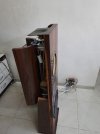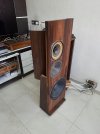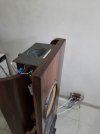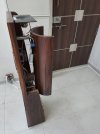Vineethkumar01
Well-Known Member
I don't have anything to say regarding this speaker with respect to it being the preferred speaker to you.My pick KEF R11;
Why :
Almost flat frequency. - let’s hear the recording without adding or removing much
Excellent directivity - directivity is mostly forward so, less affected from sidewalls like traditional speakers. Placement isn’t going to be a big issue in the room in terms of the sidewall reflection.
Excellent low frequency extension-can work without a sub
Low distortion- now this is where it gets really interesting. If you look at this graph below. This is how we calculate distortion in percentage
THD to dB - convert percent % to decibels dB percentage voltage % vs per cent converter THD+N total harmonic distortions calculation signal distortion factor attenuation in dB to distortion factor k in percent decibel damping - sengpielaudio Sengpiel
Calculate THD and distortions decibels dB to percentage % per cent percent voltage % vs converter and dB signal distortion THD+N total harmonic distortions factor attenuation damping - Eberhard Sengpiel sengpielaudiowww.sengpielaudio.com
We can hear distotion in a different way for different frequencies. But anything with these numbers are close to inaudible. What does that mean, I can push up the loudness levels of several bands here without distortion reaching audble levels. So this speaker can be eqed to literally any other speaker and still will not add distortion doing so.
View attachment 66185
The soundstage of this speaker is limited to the directivity to the front. So if you remove the shadow flare may be it would work sideways(I won’t do it)
This also means if I play a 40 hz tone, it vibrates equivalent to its time domain equivalent in terms of strokes and low distotion suggests there is no “overhang or swinging” by the drivers meaning in audiophile terms- excellent timing.
4. Coaxial with no problems exhibited by traditional coaxial. It’s very hard to get a coaxial right. Problem is you have a midrange that would vibrate which is the wave guide for the tweeter.
Kef managed to fix this problem with the tangerine waveguide and the ribs on the cone to direct it without any flaws.
Also coaxial means the best possible coherence between mid and the tweeter for accurate soundstage representation. Cymbals won’t sound above or below the vocals if recording doesn’t have it.
To me, there is nothing better than this you can buy under 5 lakhs may be even in 10 lakhs.
The stock sound has some flaws (minor) but with little bit eq it’s tunable to perfection.
Low impedance change with frequency - means it has lower amount of sound change with amp impedance change
High sensitivity- low number of parts in crossover (it’s laughable!) sensibility is high due to less power wastage.
Driver engineering has taken huge steps further hear as I won’t be surprised to see even less parts in the next gen.
But claiming that it is the current state of the art w.r.t objective measurements will put objectivists at shame..
I am assuming the measurements are coming from here: https://www.audiosciencereview.com/...11-quick-measurements-single-vs-bi-amp.20093/
This is an in room response measurement which is valid only in that particular room. For getting an estimate of its raw performance, you need at least quasi-anechoic or free field polar measurements. The set of graphs are exaggerated. Its 'y' axis scaling should show a dynamic range of 50 dB for it to be of any use. Instead it is 70 dB here.
"Almost flat frequency. - let’s hear the recording without adding or removing much"
This is a speaker that is meant to be heard in the far field. How can you say that it has almost flat frequency response at listening position without seeing a full CEA 2034 Spinorama or at least without a 'predicted in room response'? Don't you see the boundary interference related dips around 100 Hz region. The graph itself varies 15 dB between its highest and lowest points. I can assure you it is not flat in that room.
"We can hear distotion in a different way for different frequencies. But anything with these numbers are close to inaudible."
Those THD measurements are useless for the most part. Get the harmonic distortion in terms of the idividual components. then we can talk. If anything is relevant look at the odd order harmonic distortion. For reading more about perception of non linear distortion check, here:
http://www.gedlee.com/Papers/Distortion_AES_I.pdf and http://www.gedlee.com/Papers/Distortion_AES_II.pdf. This will atleast put things in some context. More important than harmonic distortion (which doesnt correlate much with perceptable distortion) is the intermodulation distortion. Let us look at that and then make claims about low distortion.
"The soundstage of this speaker is limited to the directivity to the front."
No. Can't say without Spinorama. Just looking at KEF R3's spin and making conclusions about this W-W-MT-W-W vertical driver array is useless.
"So if you remove the shadow flare may be it would work sideways(I won’t do it)"
The shadow flare is not there for looks. It is to smoothen out directivity. It could be a bad implementation by KEF. But the idea is this: https://www.diyaudio.com/community/...ver-full-range-line-array.242171/post-6526244
Better wavefront expansions leads to better directivity.
"This also means if I play a 40 hz tone, it vibrates equivalent to its time domain equivalent in terms of strokes and low distotion suggests there is no “overhang or swinging” by the drivers meaning in audiophile terms- excellent timing."
Dont even think about this. It is really hard to say about perceptible time domain issues with a impulse response and step response available. So predicting timing without that is of no use.
"The stock sound has some flaws (minor) but with little bit eq it’s tunable to perfection"
Diffraction issues are not solvable with EQ because those are linear time/space varying issues. One will screw up the response with EQ
"High sensitivity- low number of parts in crossover (it’s laughable!) sensibility is high due to less power wastage."
Yeah it is laughable. Sensitivity is not high just because of the crossover. The sensitivity comes from the vertical driver array.
"Driver engineering has taken huge steps further."
Finally I agree with something. Because drivers like these are there: https://purifi-audio.com/ptt6-5x08-nfa-01/
Conclusion. Many objective parameters don't mean what we think without formal acoustics training. Even then it is a bit hard. Acoustics is bit counter intuitive. Instead of learning everything like this one can just go audition, decide and be happy..





